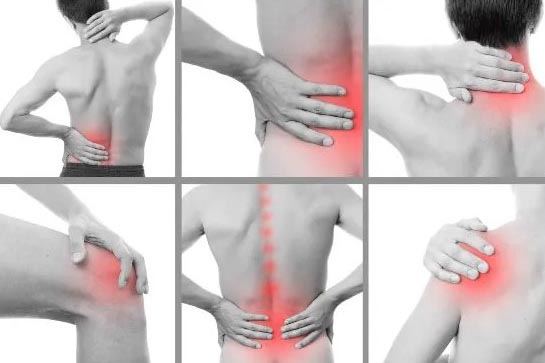Study finds that 42.6 percent of those infected with COVID-19 exhibit persistent musculoskeletal pain
Nikhil Prasad Fact checked by:Thailand Medical News Team Aug 29, 2024 1 year, 1 month, 2 weeks, 5 days, 25 minutes ago
Medical News: COVID-19's Lingering Shadow on Musculoskeletal Health
As the world continues to grapple with the aftermath of the COVID-19 pandemic, a new health concern has emerged: the significant rise in musculoskeletal pain among those who have recovered from the virus. Researchers from the First Affiliated Hospital of Fujian Medical University and Fujian Provincial Institute of Orthopedics in China conducted a comprehensive study to understand the prevalence and risk factors associated with musculoskeletal pain following COVID-19 infection. This
Medical News report delves into their findings, highlighting the long-term impact of COVID-19 on musculoskeletal health and the factors that contribute to this persistent pain.
 42.6 percent of those infected with COVID-19 exhibit persistent musculoskeletal pain
Understanding the Study: A Glimpse into the Methodology
42.6 percent of those infected with COVID-19 exhibit persistent musculoskeletal pain
Understanding the Study: A Glimpse into the Methodology
The study, which was carried out using a cross-sectional design, surveyed over 1,500 participants who had previously contracted COVID-19. Through an online platform, these individuals provided insights into their demographic characteristics, COVID-19 infection history, and the presence of musculoskeletal pain, both before and after their infection. The survey aimed to capture a broad range of data, including the severity and frequency of pain, as well as the participants' healthcare-seeking behaviors.
Researchers found that musculoskeletal pain, which includes pain in muscles, bones, joints, tendons, and ligaments, became significantly more prevalent following COVID-19 infection. The study revealed that 42.6% of the participants reported experiencing musculoskeletal pain after contracting the virus, a notable increase from pre-infection levels.
Key Findings: What Contributes to Musculoskeletal Pain Post-COVID-19?
One of the most striking findings of the study is the identification of specific factors that increase the likelihood of developing musculoskeletal pain after COVID-19. Higher education levels and a greater number of concomitant symptoms during the infection were found to be significant risk factors. This suggests that individuals who are more educated might be more susceptible to developing this condition, possibly due to the nature of their work, which often involves prolonged sitting and less physical activity.
On the other hand, the study also identified protective factors. Longer exercise durations and higher Perceived Stress Scale (PSS-10) scores were associated with a lower risk of developing musculoskeletal pain. This indicates that regular physical activity and better stress management could play a crucial role in mitigating the risk of post-COVID musculoskeletal pain.
The Impact on Healthcare-Seeking Behavior
Interestingly, despite the prevalence of musculoskeletal pain, the study found that only a small fraction of those affected sought medical attention. Specifically, only 77 out of 643 individuals with musculoskeletal pain reported seeking treatme
nt. The study explored various factors that influence the decision to seek medical care, revealing that income level, pain severity, pain frequency, and PSS-10 scores were significantly related to the willingness to seek treatment.
This reluctance to seek medical attention raises concerns, particularly as untreated musculoskeletal pain can lead to chronic conditions, decreased quality of life, and long-term disability. The study emphasizes the need for increased awareness and better access to healthcare services for individuals experiencing post-COVID musculoskeletal pain.
Why Is This Important? The Broader Implications of the Findings
The findings of this study have significant implications for public health. With a large proportion of the population experiencing musculoskeletal pain after COVID-19, there is a pressing need for targeted interventions to prevent and manage this condition. Public health campaigns should focus on promoting regular physical activity, stress management, and the importance of seeking medical care for persistent pain.
Furthermore, the study's findings highlight the need for healthcare providers to be vigilant in identifying and treating musculoskeletal pain in COVID-19 survivors. As this condition can significantly impact quality of life and work productivity, early intervention is crucial in preventing long-term complications.
Conclusion: A Call to Action
In conclusion, the study findings shed light on the hidden aftermath of COVID-19: the significant and persistent impact of musculoskeletal pain. With nearly half of the participants reporting this condition, it is clear that musculoskeletal pain is a common and concerning complication of COVID-19. The study's findings underscore the importance of physical activity, stress management, and timely medical intervention in managing this condition.
As the world continues to recover from the pandemic, it is essential to address the long-term health consequences of COVID-19. By increasing awareness and providing targeted interventions, we can help those affected by musculoskeletal pain to regain their quality of life and prevent further complications.
The study findings were published in the peer-reviewed journal Frontiers in Public Health.
https://www.frontiersin.org/journals/public-health/articles/10.3389/fpubh.2024.1422659/full
For the latest COVID-19 News, keep on logging to Thailand
Medical News.
Read Also:
https://www.thailandmedical.news/news/the-lack-of-data-on-musculoskeletal-involvement-after-mild-to-moderate-covid-19-infection
https://www.thailandmedical.news/news/musculoskeletal-and-neuropathic-pain-in-the-wake-of-the-covid-19-pandemic
